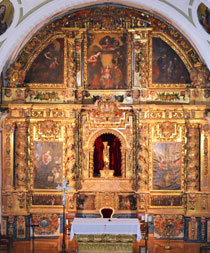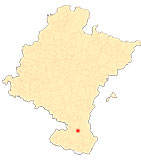Sanctuary of Nuestra Señora del Yugo
By Ricardo Fernández Gracia
The main altarpiece
The primitive altarpiece was the work of the Tudela workshop painter Juan de Lumbier and was executed in 1619. Of the current set of altarpieces and paintings preserved inside the church, the main altarpiece with its elegant and dynamic salomonic elements and richly polychrome fleshy decoration stands out. It was made in 1679, with the Tudela resident masters Pedro Biniés and José Serrano giving guarantees for its execution, although its style and invoice lead us to relate the piece to altarpieces by Sebastián de Sola y Calahorra and Francisco Gurrea, the same ones who considered the gilding of the piece to have been well done in 1685 and who also made the main altarpiece of the Rosario de Corella at the same time.
The altarpiece is structurally composed of a bench with three sections, on which is mounted a body articulated by salomónicas and a semicircular attic. The boxes of the compartments house oil paintings on canvas and the whole piece is beautifully polychromed, being an outstanding example of the application of gold and colour on wooden Structures in that period of the last third of the 17th century. The combination of a Solomonic altarpiece and paintings on canvas was something very typical of the workshops in Tudela in the second half of the 17th century, made possible thanks to the quality of its altarpiece makers and the presence in the town of the painter Vicente Berdusán, until his death in 1697. The altarpieces of the chapel of the Holy Spirit in the cathedral of Tudela, the main altarpiece of Funes and the main altarpiece of the parish church of the Rosary in Corella are some of the most outstanding examples.
The quality of the carving is visible in the atrium corbels of the bench, as well as in the garlands and decorative plant motifs and the two coats of arms of the town of Arguedas that appear in the attic, plumb with the extreme columns of the altarpiece.
-
MUNÁRRIZ, L., El santuario del Yugo, Pamplona, Imprenta y Librería de Joaquín Lorda, 1898.
-
GARCÍA GAÍNZA, M. C. and others, Catalog Monumental de Navarra. I. Merindad de Tudela, Pamplona, Government of Navarre-Archbishopric of Pamplona-University of Navarre, 1980.
-
FERNÁNDEZ-LADREDA, C., Imaginería medieval mariana, Pamplona, Government of Navarre, 1989.
-
FERNÁNDEZ GRACIA, R., "Un aspecto de la arquitectura barroca en Navarra: los camarines", conference proceedings del I congress General de Historia de Navarra. Príncipe de Viana (1988), appendix 11, pp. 149-158.
-
ECHEVERRÍA GOÑI, P. and FERNÁNDEZ GRACIA, R., "La arquitectura religiosa de los siglos XVI al XVIII en Navarra", Ibaiak eta Haranak. Guía del Patrimonio artístico y paisajístico. Navarra, vol. VIII, San Sebastián, Etor, 1991.
-
AZANZA LÓPEZ, J. J., Arquitectura Religiosa Barroca en Navarra, Pamplona, Government of Navarre, 1996.
-
FERNÁNDEZ GRACIA, R., The Baroque altarpiece in Navarre. Pamplona, Government of Navarre, 2003.












